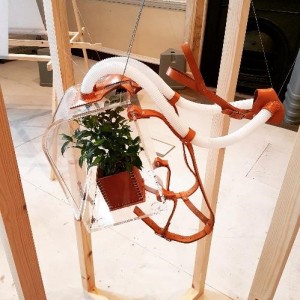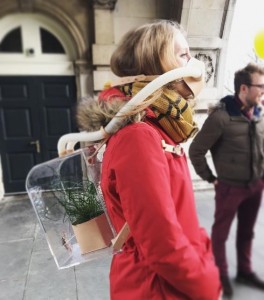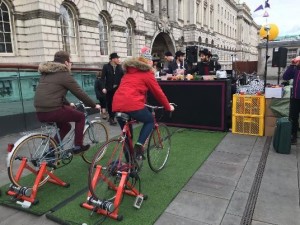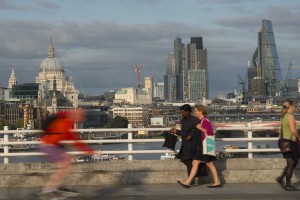With Sustainability Week now in full swing, it is time to recap what happened so far, and what events you can still get involved in.
On Monday and Tuesday we took over the space outside the Great Hall at Strand with our Sustainability Roadshow. Representatives from King’s Money Mentors, Hubbub, Veolia, Thames Plastic, RSPB, EcoSoc, Abe & Cole and Amey joined us for this, and we got the chance to chat to students about sustainability at King’s. Among other things, such as our popular recycling game, we asked students to write down what they would do if they were Principal of King’s for a day. Ideas included switching to clean energy, providing recycling training and banning non-recyclable coffee cups. We will take this feedback and see what we can do about these suggestions to make King’s more sustainable!
Highlights of other events include our Vegfest, which saw around 100 students try plant-based food (including Sheese!). We also held a bike auction at Strand, during which 16 second-hand bikes found new homes. Dr Bike were also on site to provide bike checks, and will travel with us to the other campuses over the next two days. King’s Careers & Employability ran two successful events on how to start a career in the sustainability sector, giving students the chance to ask sustainability professionals for advice.
If you have missed our events so far, you still have the chance to take part! Sustainability Week lasts until Friday the 10th February, and there are still lots of events coming up.
Tonight, there will be a panel debate on whether overconsumption or overpopulation is the biggest problem we face.
On Thursday, we will take our Sustainability Roadshow to Waterloo Campus. There will also be a Clothes Swap Shop at Waterloo in the morning. In the evening, you can attend a free screening of Tomorrow (2015), or pitch your idea on how to make King’s more sustainable at the Geography Department’s Sustainability Challenge.
Finally, on Friday we move to Denmark Hill for a seminar on why healthcare professionals should care about climate change, and we will bring our Roadshow, bike fixing sessions and Clothes Swap Show with us.
For more information, check out the full schedule here. We are looking forward to seeing you at the remaining events!






 rs
rs 
 Under certain conditions, many diesel cars will also switch off their emission controls. Legal loopholes enabled them to do this when the outside temperature falls below 18°C. While manufacturers claim this is to protect the engine, average temperatures in London mean this causes significant problems for the city’s pollution levels, as cold periods are often when pollution builds up. This is made worse by the rising number of diesel vehicles on London’s roads.
Under certain conditions, many diesel cars will also switch off their emission controls. Legal loopholes enabled them to do this when the outside temperature falls below 18°C. While manufacturers claim this is to protect the engine, average temperatures in London mean this causes significant problems for the city’s pollution levels, as cold periods are often when pollution builds up. This is made worse by the rising number of diesel vehicles on London’s roads. Therefore, even local pollution might require cross-border efforts to be tackled effectively. “It’s also someone else’s local emissions. And where are our local emissions going when they are not causing us a problem? They are going to somebody else”, says Tim Baker.
Therefore, even local pollution might require cross-border efforts to be tackled effectively. “It’s also someone else’s local emissions. And where are our local emissions going when they are not causing us a problem? They are going to somebody else”, says Tim Baker.